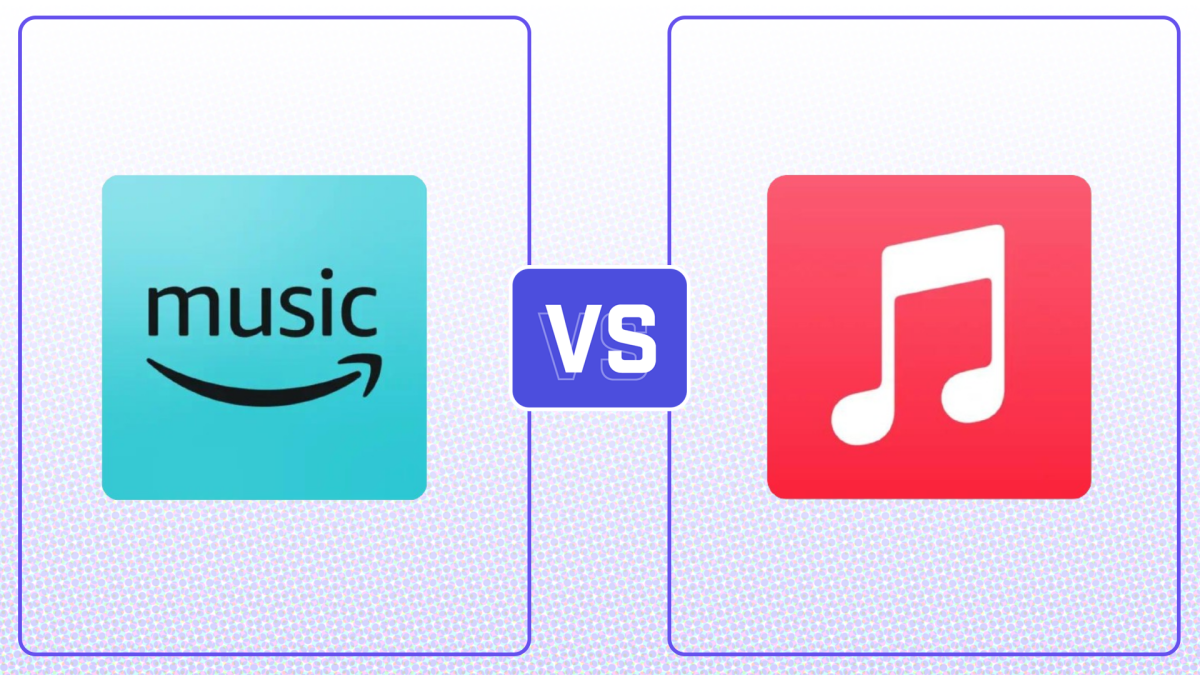
Amazon Music Unlimited
Bottom Line
Amazon Music Unlimited offers a full selection of podcasts as well as suggested content that feels more relevant and robust. But it doesn’t pay artists as much as Apple Music.
VS
Apple Music
Bottom Line
Apple Music pays artists more than Amazon Music, offers listeners higher-quality audio, and keeps things fun with features like “Apple Music Sing.”
Table of Contents
Music is personal, so choosing a music streaming service should be, too. Amazon Music and Apple Music offer similar streaming features for similar prices, but small differences between the platforms make one the best fit for most listening habits.
We compare the two music giants below in terms of pricing, playback quality, and more — just in time for Prime Day.
Subscriptions and pricing
Amazon Music offers three subscription plans with different features: Free, Prime, and Unlimited. A free plan includes ads and only allows you to shuffle an artist, album, or playlist, not to play those songs in order. Amazon Music Prime, which comes free with an Amazon Prime subscription, is ad-free but still shuffle-only. The Amazon Music Unlimited plan offers shuffle and non-shuffle listening and HD and spatial audio for $9.99 per month for Prime members ($10.99 per month for non-Prime members). The Amazon Music Family Plan includes up to six accounts and is $16.99 per month.
In this comparison, we will be focusing on Amazon Music Unlimited.
All Apple Music subscription plans offer the same features, just for different users. New subscribers get one month of Apple Music for free. After that, an individual monthly subscription is $10.99 per month, and Apple Music Family Plan (up to five accounts) is $16.99 per month. Students can choose the Apple Music Student Plan at $5.99 per month.
Winner: Tie
Music quality
Both Amazon Music Unlimited and Apple Music offer Dolby Atmos, a surround sound technology developed by Dolby Laboratories, as their highest streaming quality. Dolby Atmos is a huge upgrade to the compressed crunch of competing platforms like Spotify, which does not offer playback at such a high quality. Atmos pushes ad-libs and hidden instrumentals to the foreground, making the music sound much more detailed.
Not all songs on Amazon Music Unlimited and Apple Music are available in Dolby Atmos, but tracks that are playable at that quality will be marked with a label. Amazon Music Unlimited tracks range in quality from standard definition (SD) audio to high-definition (HD) and ultra-high-definition (UHD) lossless formats. The majority of Apple Music tracks, meanwhile, are available in lossless audio as a default, which is another win over competitor Spotify.
Winner: Apple Music
Mobile app features
Both Amazon Music Unlimited and Apple Music offer an iPhone mobile app. Since most people listen to music on the go, we spent our time using these apps and listening to music on mobile.
On both apps, song lyrics are very easy to access on screen. On some songs, Apple Music displays a cute animation of album art, and an “Apple Music Sing” feature lowers the artist’s voice so you can more easily sing over the song’s instrumental. Amazon Music Unlimited’s “X-Ray” feature displays fun facts about the artist as a song plays.
If you use an iPhone, iPad, Apple Watch, Apple TV 4K, Mac, or HomePod speakers, Apple Music is already conveniently available on your device. However, while Apple has a separate app for podcasts, the Amazon Music app provides access to both music and podcasts. Simply choose your preference in the app’s “Home” and “Library” tabs by toggling between “Music” and “Podcasts” at the top of the screen.
After using both apps, Amazon Music Unlimited edged out Apple with a selection of suggested content that felt more relevant and robust and with its inclusion of podcasts in-app. But Apple Music’s user interface felt more intuitive and easy to use.
Winner: Tie
Artist compensation
According to the latest information made available by Apple Music in 2021, the platform pays an average of $0.01 per stream, though this varies by subscription plan and country or region. No official payment information is available from Amazon Music, but a 2021 estimate claims that the platform’s average payout is significantly lower than that of Apple Music, coming in between just $0.004 and $0.008 per stream.
Winner: Apple Music
Our winner: Amazon Music vs. Apple Music
Apple Music
Apple Music beat out Amazon Music Unlimited by offering higher audio quality, fun app features, and higher payment to artists, but we suggest trying both services yourself. Music preferences vary widely from user to user, and your favorite streaming platform may serve your needs better than an alternative.
For example, if you like to listen to the newest pop releases, you’ll probably have more luck finding them in Dolby Atmos across both Amazon Music Unlimited and Apple Music. But if you’re a classic rock devotee, music from your favorite artists may be available in varying degrees of quality across each app. For example, Journey’s Greatest Hits (2024 Remaster) album is available in “Ultra HD” on Amazon Music and “High-Res Lossless” audio on Apple Music.
We suggest taking advantage of free trial offers from each platform to see which service best fits your streaming needs.
We used an iPhone 14 Pro and both Bose QuietComfort II and Airpod Pro headphones to listen to music on each app. We listened to the same songs from each service: IVE’s “HEYA” in Dolby Atmos, Charli XCX’s “360” in Dolby Atmos, and Ben Howard’s “I Forget Where We Were” in High Res Lossless on Apple Music and HD on Amazon Music.


